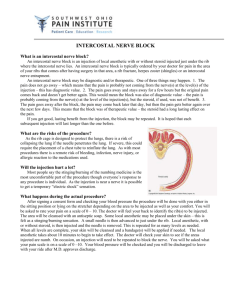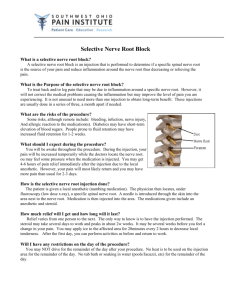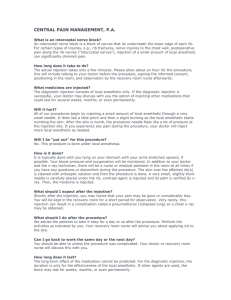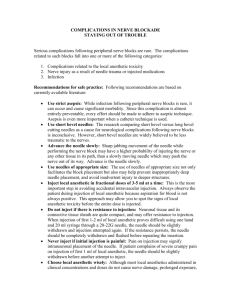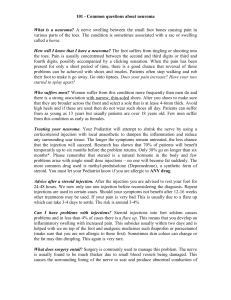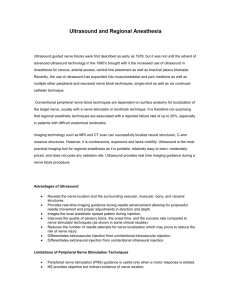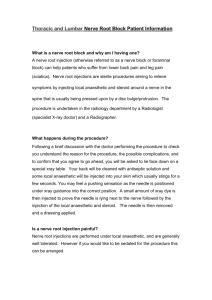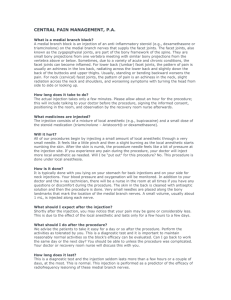What is a selective nerve root block
advertisement
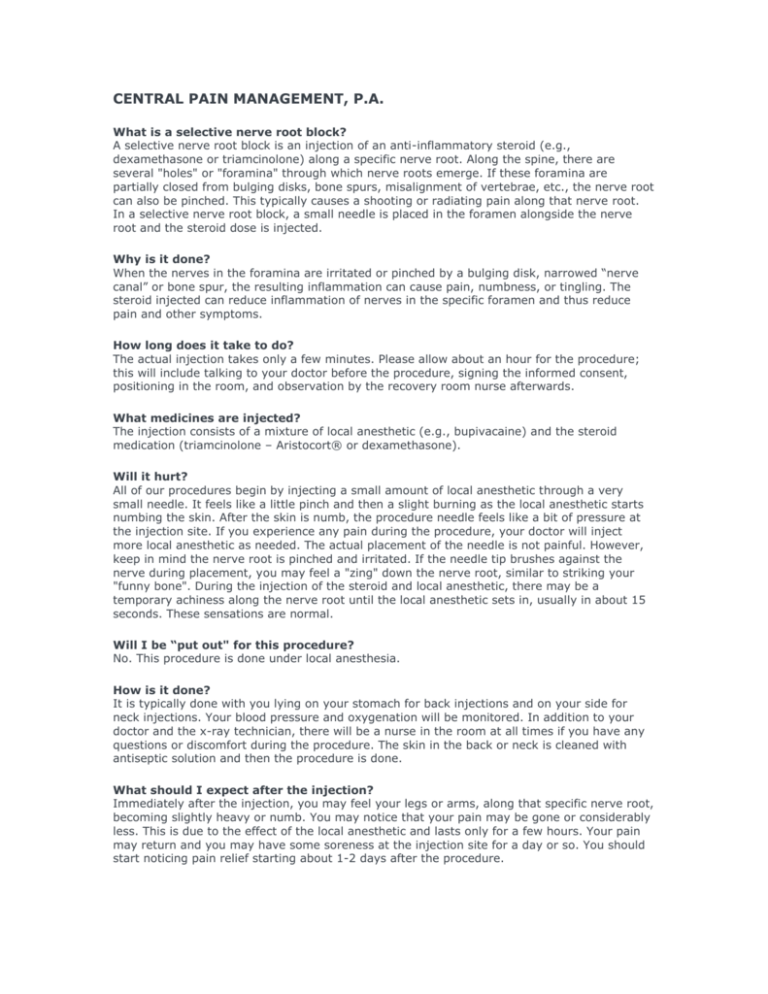
CENTRAL PAIN MANAGEMENT, P.A. What is a selective nerve root block? A selective nerve root block is an injection of an anti-inflammatory steroid (e.g., dexamethasone or triamcinolone) along a specific nerve root. Along the spine, there are several "holes" or "foramina" through which nerve roots emerge. If these foramina are partially closed from bulging disks, bone spurs, misalignment of vertebrae, etc., the nerve root can also be pinched. This typically causes a shooting or radiating pain along that nerve root. In a selective nerve root block, a small needle is placed in the foramen alongside the nerve root and the steroid dose is injected. Why is it done? When the nerves in the foramina are irritated or pinched by a bulging disk, narrowed “nerve canal” or bone spur, the resulting inflammation can cause pain, numbness, or tingling. The steroid injected can reduce inflammation of nerves in the specific foramen and thus reduce pain and other symptoms. How long does it take to do? The actual injection takes only a few minutes. Please allow about an hour for the procedure; this will include talking to your doctor before the procedure, signing the informed consent, positioning in the room, and observation by the recovery room nurse afterwards. What medicines are injected? The injection consists of a mixture of local anesthetic (e.g., bupivacaine) and the steroid medication (triamcinolone – Aristocort® or dexamethasone). Will it hurt? All of our procedures begin by injecting a small amount of local anesthetic through a very small needle. It feels like a little pinch and then a slight burning as the local anesthetic starts numbing the skin. After the skin is numb, the procedure needle feels like a bit of pressure at the injection site. If you experience any pain during the procedure, your doctor will inject more local anesthetic as needed. The actual placement of the needle is not painful. However, keep in mind the nerve root is pinched and irritated. If the needle tip brushes against the nerve during placement, you may feel a "zing" down the nerve root, similar to striking your "funny bone". During the injection of the steroid and local anesthetic, there may be a temporary achiness along the nerve root until the local anesthetic sets in, usually in about 15 seconds. These sensations are normal. Will I be “put out" for this procedure? No. This procedure is done under local anesthesia. How is it done? It is typically done with you lying on your stomach for back injections and on your side for neck injections. Your blood pressure and oxygenation will be monitored. In addition to your doctor and the x-ray technician, there will be a nurse in the room at all times if you have any questions or discomfort during the procedure. The skin in the back or neck is cleaned with antiseptic solution and then the procedure is done. What should I expect after the injection? Immediately after the injection, you may feel your legs or arms, along that specific nerve root, becoming slightly heavy or numb. You may notice that your pain may be gone or considerably less. This is due to the effect of the local anesthetic and lasts only for a few hours. Your pain may return and you may have some soreness at the injection site for a day or so. You should start noticing pain relief starting about 1-2 days after the procedure. What should I do after the procedure? We advise the patients to take it easy for a day or so after the procedure. Perform the activities as tolerated by you. Your recovery room nurse will advise you about applying ice to the site. Can I go back to work the same day or the next day? You should be able to unless the procedure was complicated. Your doctor or recovery room nurse will discuss this with you. How long does it last? The long-term effect of the medication cannot be predicted. Usually, the immediate effect is from the local anesthetic injected. This wears off in a few hours. The steroid starts working in about 1-2 days and its effect can last for several days to a few months. How many injections do I need to have? The typical series of injections is for about three, spaced about a month apart. You should expect a gradual overall improvement in pain after each injection. Can I have more than one injections? Yes, the injection can be repeated. Your doctor will discuss this with you, based on your response to the first injection. How will I know if it will help? It is very difficult to predict how helpful injections will be. Generally, patients who have "radicular” symptoms (radiating outward or downward, like sciatica) respond well. Patients with recent onset of pain may respond much better than ones with longstanding pain. What are the risks and side effects? Overall, this procedure has very few risks. However, as with any procedure, there are some risks and side effects you should know about. Commonly encountered side effects are increased pain from the injection (usually temporary), inadvertent puncture of the “sack” containing spinal fluid (may cause headaches), infection, bleeding, nerve damage, or no relief from your usual pain. Side effects of the injected steroid may include weight gain, increase in blood sugar (mainly in diabetics), water retention, suppression of your own natural production of steroids, or temporary suppression of your immune system. Who should not have this injection? The following patients should not have this injection: if you are allergic to any of the medications to be injected, if you are on a blood-thinning medication (e.g. coumadin, injectable heparin), or if you have an active infection going on.

